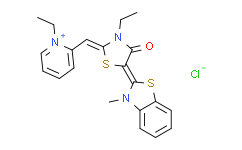| 中文名称: | MKT-077 | ||||
|---|---|---|---|---|---|
| 英文名称: | MKT-077 | ||||
| 别名: | FJ-776;(2Z,5E)-3-ethyl-2-[(1-ethylpyridin-1-ium-2-yl)methylidene]-5-(3-methyl-1,3-benzothiazol-2-ylidene)-1,3-thiazolidin-4-one chloride | ||||
| CAS No: | 147366-41-4 | 分子式: | C21H22ClN3Os2 | 分子量: | 432 |
| CAS No: | 147366-41-4 | ||||
| 分子式: | C21H22ClN3Os2 | ||||
| 分子量: | 432 | ||||
基本信息
|
产品编号:M10848 |
|||||
|
产品名称:MKT-077 |
|||||
|
CAS: |
147366-41-4 |
储存条件 |
粉末 |
-20℃ |
四年 |
|
分子式: |
溶于液体 |
-80℃ |
两年 |
||
|
分子量 |
432.00 |
-20℃ |
一个月 |
||
|
化学名: |
|||||
|
Solubility (25°C) |
体外 |
DMSO |
13mg/mL (30.09mM) |
||
|
Ethanol |
10mg/mL (23.14mM) |
||||
|
Water |
86mg/mL (199.07mM) |
||||
|
体内 |
现配现用 |
|
|||
|
<1mg/ml表示微溶或不溶。 |
|||||
|
普西唐提供的所有化合物浓度为内部测试所得,实际溶液度可能与公布值有所偏差,属于正常的批间细微差异现象。 |
|||||
|
请根据产品在不同溶剂中的溶解度选择合适的溶剂配制储备液;⼀旦配成溶液,请分装保存,避免反复冻融造成的产品失效。 |
|||||
制备储备液
|
浓度
溶液体积 质量 |
1mg |
5mg |
10mg |
|
1mM |
2.3148mL |
11.5741mL |
23.1481mL |
|
5mM |
0.4630mL |
2.3148mL |
4.6296mL |
|
10mM |
0.2315mL |
1.1574mL |
2.3148mL |
|
50mM |
0.0463mL |
0.2315mL |
0.4630mL |
生物活性
|
产品描述 |
一种花菁染料,也是一种热休克蛋白 70 (Hsp70) 抑制剂,且具有显着的抗肿瘤活性。 |
|
靶点/IC50 |
HSP70 |
|
体外研究 |
MKT-077 is a rhodacyanine dye and also a heat shock protein 70 (Hsp70) inhibitor which exhibits significant antitumor activity. MKT-077 treatment (0.1 to 10 µM dose ranges) for 48 hours can effectively decrease TT cell viability. MKT-077 treatment results in accumulation of cells in the G0/G1 phase in a dose-dependent manner, and also increases sub-G0/G1 phase population in TT cell culture in a dose-dependent manner. MKT-077 also downregulates cellular levels of the proliferation marker, Ki67, and the S-phase transcription factor, E2F-1, in TT and MZ-CRC-1 cells. Moreover, flow cytometry using different doses of MKT-077 reveales that TT cells can uptake and retain MKT-077 at significantly higher levels than MZCRC-1 cells[1]. MKT-077 has EC50 values of 1.4±0.2 and 2.2±0.2μM against MDA-MB-231 and MCF7 breast cancer cells,respectivelyl |
|
体内研究 |
Systemic administration of MKT-077 significantly delays the growth of TT xenografts in mice throughout the treatment. At the end of MKT-077 treatment, it is found that tumor weights are about two-times less in MKT-077-treated group than in control group. MKT-077 treatment also results in weight loss and general toxicity in animals. Results show that the succinate-induced, ADP-stimulated respiratory rate in mitochondria isolated from the liver of rats treated with a bolus i.v. injection of 15 mg MKT-077 1kg body weight each day for 5 days is significantly lower than that of untreated controls |
推荐实验方法(仅供参考)
|
细胞实验: |
|
|
Cell Assay |
Cells are incubated with 1 µM MKT-077 and 100 nM Mitotracker Green FM in culture medium for 30 minutes at 37°C in the dark, washed with PBS, switched into phenol-red free medium before visualizing fluorescence under a microscope. Pictures are acquired and processed with software. For flow cytometric measurement, MKT-077-treated cells are resuspended in 0.1% bovine serum albumin/PBS and analyzed by flow cytometry. Data from 20,000 cells are analyzed using FCS Express software. |
|
动物实验: |
|
|
Animal Administration |
The 1×107 TT cells in 200 µL Hank's balanced salt solution are inoculated subcutaneously into the rear flanks of 6-week-old female athymic nude (nu/nu) mice. Once palpable, tumors are measured using calipers at intervals indicated in the text. When tumor volume reaches 100 mm3, mice are sorted into groups of 8 to achieve equal distribution of tumor size in all treatment groups. Group 1 receives only the vehicle (1:9 mixture of DMSO/saline) and group 2 receives MKT-077 (10mg/kg body weight/dose). A 200 µL of ether solution is administered by intraperitoneal injection every 2 days (total 10 doses). At the end of the experiments, animals are euthanized by CO2 asphyxiation. |
本计算器可帮助您计算出特定溶液中溶质的质量、溶液浓度和体积之间的关系,公式为:
质量 (g) = 浓度 (mol/L) x 体积 (L) x 分子量 (g/mol)
摩尔浓度计算公式
用本工具协助配置特定浓度的溶液,使用的计算公式为:
开始浓度 x 开始体积 = 最终浓度 x 最终体积
稀释公式
稀释公式一般简略地表示为:C1V1 = C2V2 ( 输入 输出 )








